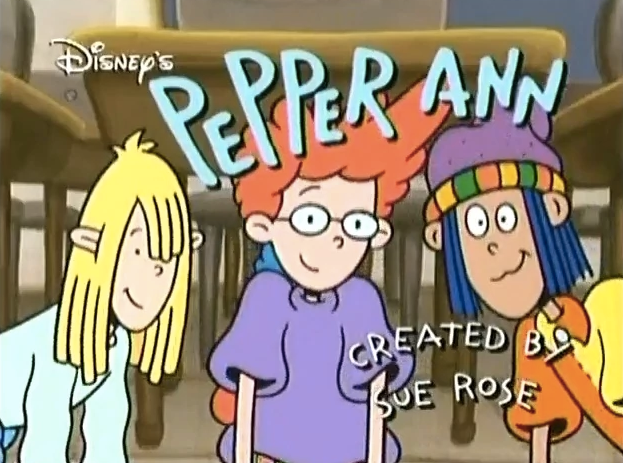
The world is burning, yes, but let’s take a moment to consider “Pepper Ann,” a ’90s cartoon that featured one of the most dynamic portrayals of adolescence on television.
Twenty years ago Wednesday, the redheaded tween who was much too cool for seventh grade entered the pantheon of Saturday morning toons. It was quite unlike any other cartoon at the time, a progenitor of the quirky preteen heroine of shows like “As Told by Ginger” and “Lizzie McGuire.”
The show debuted in 1997, the brainchild of executive producer Sue Rose and her nearly all-female team that included director Sherie Pollack and head writer Nahnatchka Khan. It centered on Pepper Ann Pearson, a spunky 12-year-old who loved pizza, soccer, comic books and video games.
Pepper Ann was aggressive, bossy, loud and “unladylike,” but her consistent quest to be “cool” and conform never compromised these supposedly unfeminine traits. Her best friend Nicky was soft-spoken and wildly intelligent, while her best friend Milo, a native Hawaiian boy, was artistic and sensitive. Her little sister, Moose, was a wise-beyond-her-years 8-year-old who is decidedly gender-ambiguous ― her masculinity is never picked at or prodded. Meanwhile, Pepper Ann’s mother, Lydia, was a hardworking single mother, an outspoken, self-professed feminist who was consistently trying to instill in her two daughters a sense of independence and self-acceptance.
Characters like these may be a dime a dozen today, but it’s important to remember that most cartoons in the ’90s centered on male characters (whether human or anthropomorphic) and focused on male stories. And when there were female characters, a la “Garfield” or the “Teenage Mutant Ninja Turtles,” these characters often went by the Smurfette Principle ― the trope of including women as tokens who exist solely to support the storylines of male leads.
“Pepper Ann” was something different, a show chock-full of female characters who (by the standards of a half-hour Saturday cartoon) were afforded an enormous amount of complexity. In one season 2 episode, Pepper Ann’s mother took her on a retreat to a feminist camp where, some exaggerated feminist caricatures aside, Pepper Ann got to learn about the “glass ceiling,” reflect on her own womanhood, and catch a glimpse into her mother’s perspective by hearing from her mom’s generation.
The show was not necessarily a radical or revolutionary treatise on feminism or gender identity, but it was special. That specialness was being recognized even upon its debut ― a 1997 Variety article lauded it as part of a new school of “girl power toons” on television that included “Daria” and “The Legend of Calamity Jane.”
Rose, the executive producer, told the publication at the time: “Good, smart, funny shows with girl characters are something everyone can embrace. Pepper Ann is a kid who happens to be a girl. Gender doesn’t have to enter into it.”
In a ideological paradise, gender really wouldn’t have to enter into it, but gender was such a huge part of what made “Pepper Ann” work. Pepper Ann’s love of pizza, video games and soccer was not what made her interesting. What made her interesting was that she inhabited a world in which young people were allowed and encouraged to embrace the multiplicities of their identities. Pepper Ann’s tomboyishness did not make her stand out.
What made her stand out was her heart, her love for her friends, her constant struggle between trying to conform and trying to be herself, and the space that was made for her (and the young audience) to explore all these things without judgment.
The place of the tween girl in pop culture is a difficult one. Young girls are patronized and condescended to; they’re fetishized and deified, either for their sexuality or for this false and potentially harmful idea that “teen girls will save us all.” No, teen girls will be and feel and do whatever they want.
Nostalgia has a way of becoming all the more potent when the present seems particularly bleak. Today, there are tween heroines on Nickelodeon and Disney that encompass much of what made shows like “Pepper Ann” special ― Disney’s new show “Andi Mack,” which chronicles an Asian-American seventh-grader coming to terms with the fact that her sister is actually her mother (you read that right) comes to mind.
There’s progress; there are indeed teen and tween characters who have taken the spirit of this underrated ’90s cartoon and expanded on its themes. But given that “Pepper Ann” existed in a pre-internet time devoid of buzzwords and online discourse about feminism and representation, it’s fascinating that it existed the way it did, or at all.
And maybe that’s something today’s television landscape for young girls can take away from it ― the fact that these characters can and should challenge gender stereotypes not just for the sake of challenging them, but for the sake of being their authentic selves.
